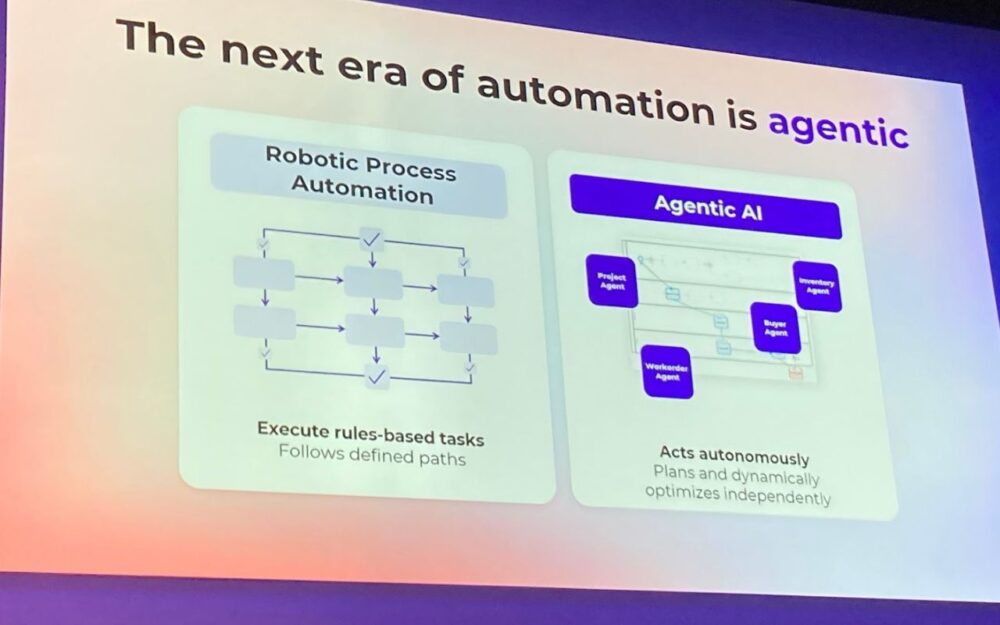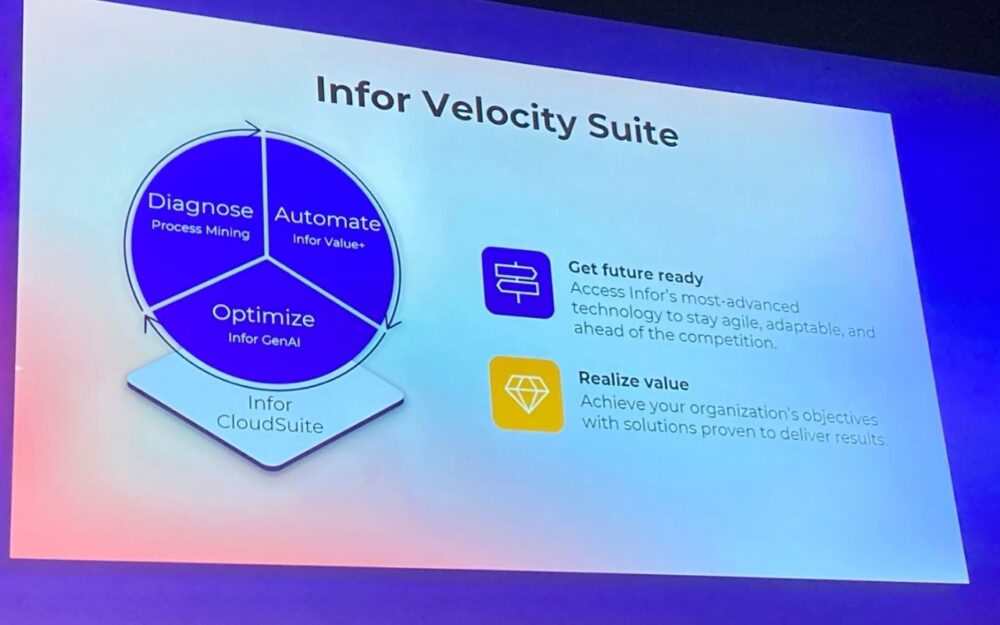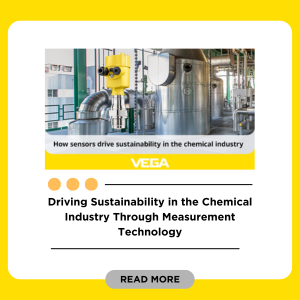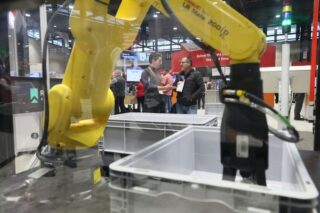Recently added features to Infor’s industry-specific enterprise resource planning (ERP) software are designed to enhance company processes and generate measurable value through the use of AI and Agentic AI. During an event organized a few weeks ago by the company in Mainz, Germany, DirectIndustry spoke with CEO Kevin Samuelson to learn more.
In early October 2025, during an event in Germany we attended, global enterprise software company Infor has announced a major update to its portfolio. The company unveield a suite of built-for-industry AI agents that aim to redefine operational workflows across manufacturing, distribution and service industries. Those agents should require minimal training before helping organizations achieve continuous process optimization in core operational areas such as projects, products, supply chain and workforce operations.
In addition to the agents, Infor has also introduced Infor Leap, a cloud migration offer aimed at helping customers moving from on-premise IT infrastructure. It is designed to overcome common migration barriers such as implementation delays and budget overruns, enabling companies to unlock the benefits of AI-driven solutions. Kevin Samuelson, CEO at Infor explains the details of the launch:
“Everyone’s talking about AI,” he says, “but the challenge is actually using it for value creation.”
For Infor, a subsidiary of Koch Industries, this challenge has become a vital part of its strategy. Rather than treating generative AI as an abstract capability or an optional add-on, Infor has been embedding it directly into the operational and analytical structure of its products. As a result, automated process optimization in manufacturing, healthcare, retail, and other sectors could evolve rather quickly.

Infor Concentrates on Nine Industries – And Invests Heavily
Samuelson’s vision for AI in ERP is rooted in Infor’s core product. ERP systems sit at the heart of a company’s operations, holding a vast source of enterprise data.
“ERP tends to be the system of record,” he explains. “It really runs the core operations of a company.”
That amount of data – combined with Infor’s long-standing focus on industry-specific solutions – gives the company a fertile ground for AI innovation.
“We’ve focused on nine industries,” says Samuelson. “That allows us to go much more deeply into industry processes. Having both the data and the process knowledge enables us to build AI capabilities that are very unique.”
Wolfgang Kobek, Executive Vice President and General Manager International Business at Infor, outlines the overall goal:
“The long-term value of industry specificity can drive significant value to our customers.”
Infor aims at making much more of what happens within their customers’ operations automated to drive more insights. And to compound that into more and more capabilities for them. Martin Müller, Vice President Sales, underlines this vision:
“We’ve invested billions in the last few years. We want to go the last mile in the ERP area and provide customers with the functionality they need. But we also have to move forward. And that’s exactly what’s happening with AI.”
Interested in Agentic AI? Read our story on how AI agents are transforming industry
AI-Agents Enabling a “Quantum Leap in Capability”
At the core of this strategy lies so-called agentic AI. While large language models (LLMs) like ChatGPT are able to provide text, Infor’s agentic AI goes one step further: it’s taking actions in an intelligent way. An agentic system, in Infor’s design, starts with an LLM but is layered with tools that can execute operational tasks inside the ERP.
“It’s a quantum leap in capability,” CEO Samuelson says.
The return on investment for customers using this new technology is supposed to be measured particularly in two areas. One is process automation, the other is directly impacting revenue and margin. Pricing optimization based on analysing demand patterns and inventory levels is one example.
In a world increasingly concerned with AI ethics and data protection, Infor’s partnership strategy plays a central role. The company builds exclusively on cloud-computing provider Amazon Web Services (AWS), taking advantage of the hyperscaler’s infrastructure, R&D and security investments.
“That deep integration with AWS,” says Samuelson, “allows us to leverage €80 billion in R&D and security work that they do.”
Infor’s software products are built with what’s called multi-tenancy, meaning every customer runs on the same version of the software. That uniformity improves security and consistency. On top, innovations can be generated without impacting customer’s products.

Adopting AI: Overcoming Hesitation and Other Challenges
On the issue of regulation Samuelson is cautiously optimistic.
“Regulation is still in its early days. I’m slightly concerned that it is getting ahead of actual innovation,” he says. “But as value creation becomes more real and companies see their competitors taking advantage of things and driving value, I think that’s what will drive a lot of adoption. With time, we’ll better understand what elements should be regulated.”
While enthusiasm for AI is growing, many enterprises still hesitate to deploy it broadly. Infor is aware of this reluctance and sees transparency and traceability as key to overcoming it. According to Kevin Samuelson, customers want to understand how AI works and how it arrives at its findings.
“We’ve built auditing capabilities into our AI so customers can see exactly the steps the system took and how it came to a conclusion. This gives them confidence in the results.”
Furthermore, customer data used for a process, for example, is cleared in 24 hours. It is never used to train a model.
“We are training based on anonymized data, use cases and insights”, says Samuelson.
Despite the power of automation, Infor’s approach to AI is about human expertise, talent and changing skills.
“It’s not magic,” Samuelson says. “We still couple a lot of these solutions with some experts on our team that can work with customers to fine-tune outcomes, based on what they need.”
Talent acquisition is another key pillar of Infor’s strategy. The company now hires around 1,000 college graduates each year, that have extensive knowledge around new technologies but are also flexible and agile.
“This has been a game changer, also for inspiring others that have been at Infor for a while, because they can see what’s possible.”
Infor also leverages AI internally. In R&D a lot of automated coding with Amazon Q is used which makes a difference in the flexibility and capability of the engineers of the team.
Looking Ahead: Self-Improving, Self-Explaining Systems
As AI becomes an embedded layer in enterprise software, Infor is concentrating on the options that the technology entails. Samuelson concludes:
“I think we’re at the very beginning of the ability to use these technologies in really compelling and differentiated ways. And we have big ambitions to continue to evolve that. Process mining now allows us to serve up to customers how to improve processes,” he says. “But ultimately, they should be improved automatically within the system without having to get people involved.”
Thus, AI would turn ERP into a dynamic intelligent system, that does not only inform but also performs in a way that is supposed to drive true value to the user.
Read also: our guide on how to choose the right MES






![Image [BUYING GUIDE] How to Choose the Right Industrial Robot?](/wp-content/uploads/sites/3/Industrial-Robot-320x213.jpg)

![Image [Buying Guide] How to Choose the Right Safety Shoes?](/wp-content/uploads/sites/3/Safety-Shoes-320x213.jpg)


![Image [Buying Guide] How to Choose the Right AMR?](/wp-content/uploads/sites/3/AMR-320x213.jpg)